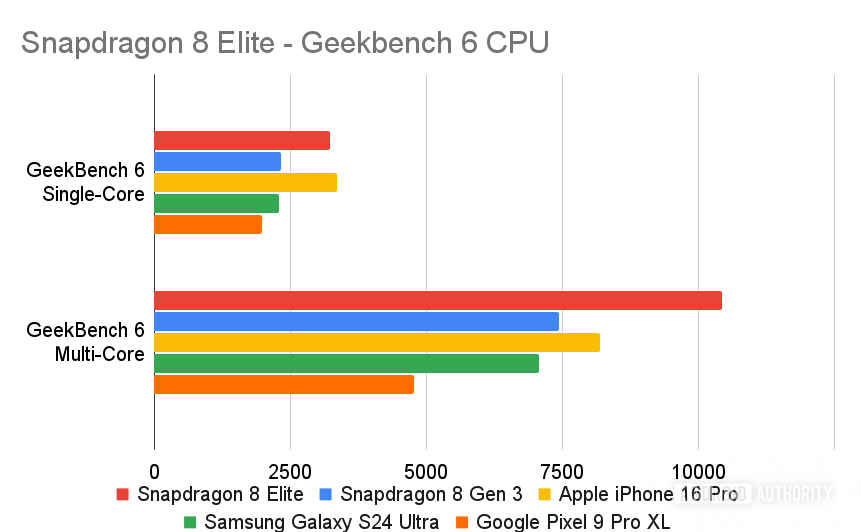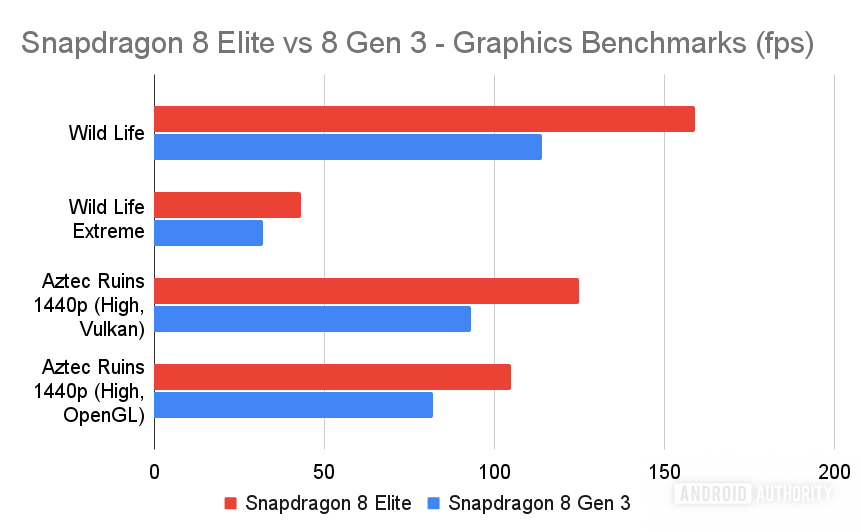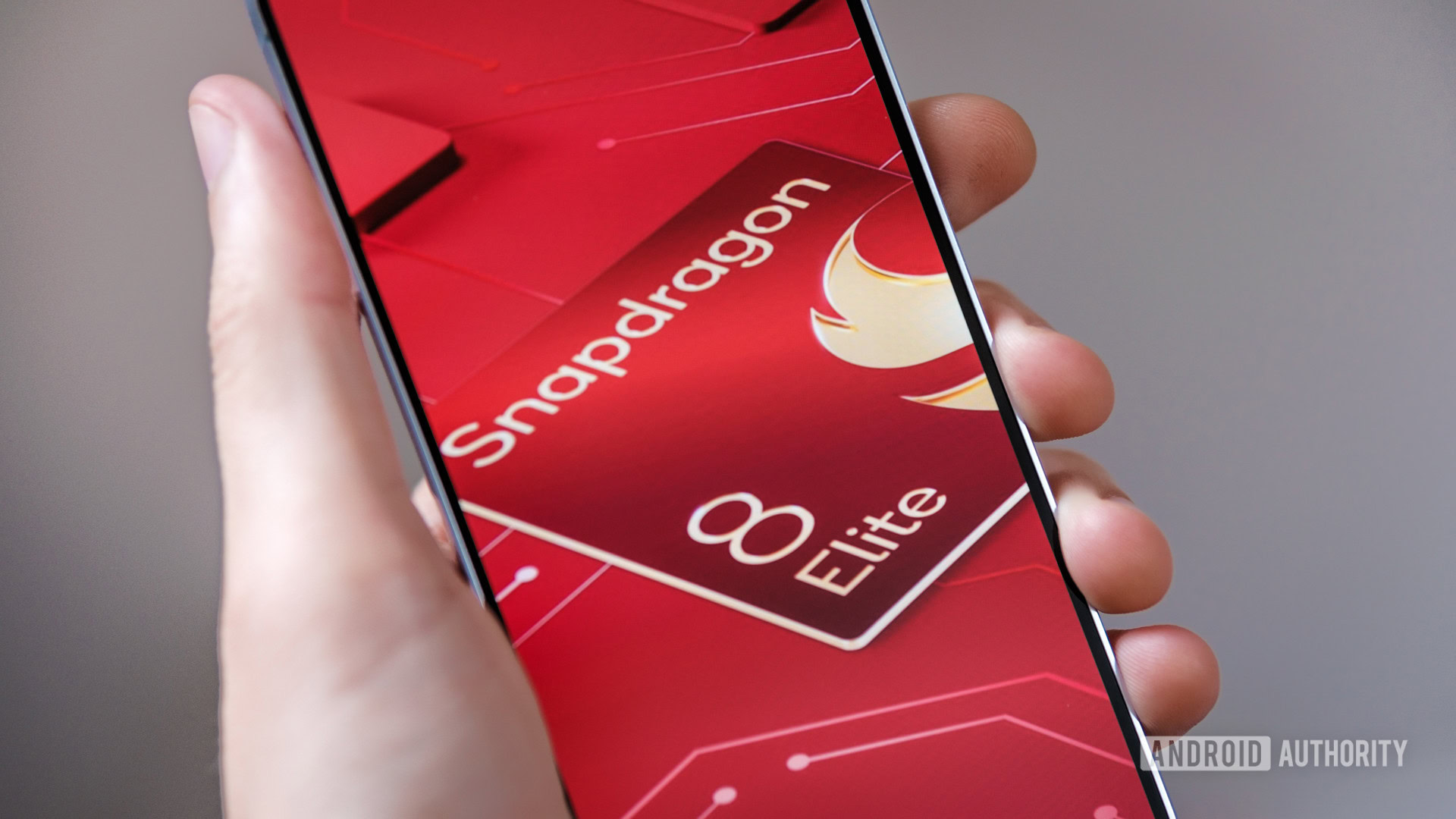Affiliate links on Android Authority may earn us a commission. Learn more.
Qualcomm claims to have the fastest smartphone chip ever and here's the evidence
Published onOctober 21, 2024
Qualcomm’s next-gen mobile processor is here, and it looks like an absolute unit. The Snapdragon 8 Elite sports a return to a custom CPU design, a brand-new GPU architecture, and even snappier AI smarts. If you’re wondering how all this compares to today’s best smartphones, Qualcomm has some preliminary benchmark figures to share with us.
Retail smartphones aren’t available yet, so Qualcomm benchmarked the chip on a reference smartphone. Its specs include the new Snapdragon 8 Elite chip with standard 4.32GHz Prime and 3.53GHz Performance CPU clock speeds. It’s paired with 24GB LPDDR5X RAM (4.8Gbps), 1TB UFS4.0 storage, and a 6.8-inch 144Hz AMOLED display — pretty high-end stuff.
Some words of caution on these, though. One, we haven’t been able to verify Qualcomm’s numbers yet, though we hope to get some hands-on time with these devices at Snapdragon Summit. Two, Qualcomm’s reference designs have often outperformed retail smartphones by a few percentage points, so treat these as an absolute best-case scenario.
Snapdragon 8 Elite benchmark results
Let’s start with the new custom CPU. It’s still running the Arm architecture but eschews Arm’s Cortex CPU cores in favor of an in-house design. For comparison, Google and Samsung use Arm parts for Tensor and Exynos, respectively, while Apple has an Arm license to design its own cores.
Speaking of Apple, let’s see if Qualcomm’s design can outpace the current CPU market leader.

Qualcomm’s Oryon CPU and Apple’s biggest CPU core inside the A18 Pro are virtually neck and neck. We calculate a deficit of less than 4% with Apple’s core, and both are clearly much faster than other CPUs currently on the market, at least in terms of single-core grunt. The 8 Elite is 63% faster than the Google Pixel 9’s Tensor G4 processor, for example.
However, Qualcomm’s Prime core achieves this with a colossal 4.32GHz clock speed, while Apple’s apparently peaks at 4.05GHz. We’ll have to see which is more power-efficient.
Qualcomm's Oryon CPU takes the battle to Apple's custom designs.
When it comes to multi-threaded workloads, the Snapdragon 8 Elite’s six Performance cores outperform Apple’s four efficiency cores. The gulf is a very noticeable 27%. However, Qualcomm has two extra cores behind it compared to Apple. On a per-core basis, Oryon looks to be about 4.5% slower than the A18 Pro’s cores, just a little more than the margin of error.
Looking more broadly, it’s 40% faster than the Galaxy S24 Ultra’s Snapdragon 8 Gen 3 and more than twice as fast as Google’s Tensor G4. The Snapdragon 8 Elite is shaping up to be a bit of a game changer for Android phones, providing you’ll actually use that extra performance.
Do Qualcomm’s graphics claims stack up?
Qualcomm provides graphic benchmark results from “off-screen” tests, sidestepping the reference device’s display specs. This is useful for apples-to-apples chip comparisons but not so much for real-world devices that we test regularly. As such, we’ve tracked down data from the Snapdragon 8 Gen 3 reference unit to see how things compare, and the results are pretty solid.

We see Qualcomm’s 40% performance improvement over the Snapdragon 8 Gen 3 manifest in 3DMark’s Wild Life test. This suggests the chip will be absolutely overkill for the vast majority of modern mobile titles and will handle cutting-edge games with high frame rates as well.
When it comes to the most demanding graphics benchmarks with cutting-edge graphical effects, the new GPU is about 34% faster, which is still an astonishing uplift for a single generation. OpenGL performance seems to have improved less but is still solid, showing a 28% gain over last year in Aztec Ruins High-Tier.
Graphics performance sees a monumental uplift too.
Qualcomm hasn’t provided a ray-tracing benchmark to back up its claim of 35% higher performance. We also don’t have stress test results to see if the 8 Elite can overcome the Achilles heel of its predecessors. We’ll be sure to run these tests ourselves when we get hands-on experience with Elite-powered smartphones.
Snapdragon 8 Elite performance early verdict

We also compared Qualcomm’s AI performance numbers, which showcase anywhere from 30% to 111% performance gains over last year, depending on the workload. But given that AI workloads are so variable, I don’t want to focus on these numbers too much at this stage.
Of course, we can only draw so many conclusions from benchmarks we haven’t run ourselves, but Qualcomm clearly seems confident in the Snapdragon 8 Elite’s capabilities.
We won't have to wait long to see the Snapdragon 8 Elite in action.
If these results are reflected in commercial smartphones, we’ll see huge generational gains in CPU and GPU performance. 20% is a more traditional year-on-year leap, but with gains appearing closer to 40%, consumers will see a much more perceivable difference in the responsiveness of their most demanding apps and games.
Perhaps the biggest takeaway is that next-gen Android smartphones look poised to finally leapfrog Apple. Snapdragon has been hot on its heels with multi-core performance and has scored graphics wins in more recent generations, but with the Snapdragon 8 Elite, Android phones look set to top the charts by considerable margins.